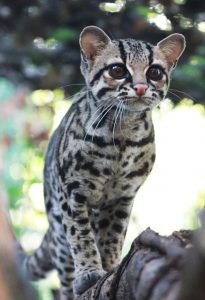
Monthly talk: Lia Summers – Shaldon Wildlife Trust
 In April we welcomed Lia Summers to talk about the work of Shaldon Wildlife Trust which runs Shaldon Zoo. This may be a very small zoo, but as the trust says in its publicity, it is a small zoo making big difference! Head Keeper Lia gave us plenty of reasons why they can say this with confidence.
In April we welcomed Lia Summers to talk about the work of Shaldon Wildlife Trust which runs Shaldon Zoo. This may be a very small zoo, but as the trust says in its publicity, it is a small zoo making big difference! Head Keeper Lia gave us plenty of reasons why they can say this with confidence.
The zoo has just five paid employees, but they are well supported by over 40 volunteers. Between them, they do a great deal of valuable work in caring for a range of animals in Shaldon and in education, but also are engaged in vital conservation work at the zoo but also work with projects around the world.
The zoo was founded in 1963, and became a charity in 1985. It is a member of BIAZA, the British and Irish Association of Zoos and Aquariums; this is the professional body representing the best zoos and aquariums in Britain and Ireland. BIAZA has over 100 zoo and aquarium members. Shaldon Zoo’s mission is to be a proactive contributor to the preservation of the wildlife of the planet, through breeding, education, research and in situ conservation.
There is a significant collection of small primates, and what Lia described as other ‘weird and wonderful animals’. There are too many to provide a comprehensive list here, but they include lemurs, tamarins, slow loris, capuchin monkeys, tortoises, pythons, margays, civets, bettongs, frogs and geckoes. Many animals in the collection are critically endangered, so the zoo’s work is vital to their survival. As small zoo, the trust is understandably proud of its high rating amongst zoos for its field conservation work.
Much of the work relates to breeding programmes – a highly complex and skilled business, not just about engineering compatible relationships, but also in ensuring that future generations are healthy and have a diverse gene pool to ensure they thrive into the future. There is constant movement of animals from one zoo to another as successful breeding programmes mean young animals can be sent to other collections. There is a constant need to study and learn, and the zoo is always looking to develop its programmes and facilities.
At present, the trust is engaged in an impressive nine conservation projects working with partners in seven or eight countries. Lia explained that it is essential to work with local partners, communities and governments to enable the work to succeed. In some countries, it can be dangerous to undertake conservation work if there is conflict with local vested interests. The trust works with local people in Madagascar to protect the habitat which supports lemurs. In Vietnam, work is undertaken with the community and local institutions to conserve civets and pangolins which are the most trafficked animals in the world. Although it is unsafe to work in some parts of Brazil, there is successful work in that country with mountain marmosets and the pied tamarind.
Lia is clearly a great enthusiast for her work and the role of Shaldon Wildlife Trust. Many members will no doubt have visited the zoo, possibly with younger generations of their family, but she was keen to encourage those who would like to visit in future to do so. The zoo welcome groups who would be able to benefit from an expert guide to talk about their work. If any member is interested in organising a group visit, I am sure there would be a good take up. If you would like some advice on how to go about this, including advertising it to other members, you may like to discuss this with a member of the committee.
John Vick
